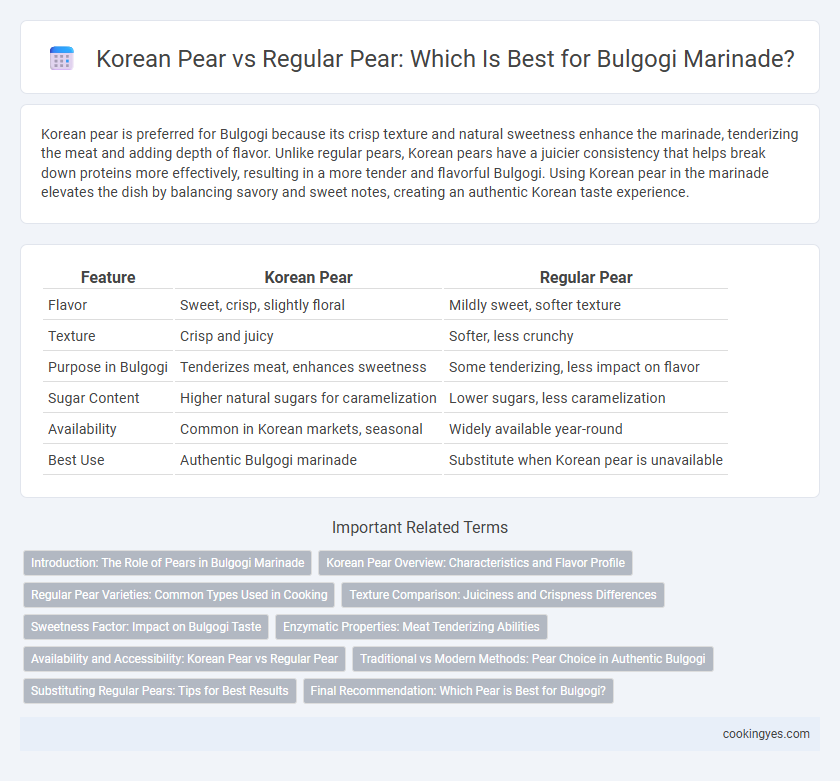Korean pear is preferred for Bulgogi because its crisp texture and natural sweetness enhance the marinade, tenderizing the meat and adding depth of flavor. Unlike regular pears, Korean pears have a juicier consistency that helps break down proteins more effectively, resulting in a more tender and flavorful Bulgogi. Using Korean pear in the marinade elevates the dish by balancing savory and sweet notes, creating an authentic Korean taste experience.
Table of Comparison
| Feature | Korean Pear | Regular Pear |
|---|---|---|
| Flavor | Sweet, crisp, slightly floral | Mildly sweet, softer texture |
| Texture | Crisp and juicy | Softer, less crunchy |
| Purpose in Bulgogi | Tenderizes meat, enhances sweetness | Some tenderizing, less impact on flavor |
| Sugar Content | Higher natural sugars for caramelization | Lower sugars, less caramelization |
| Availability | Common in Korean markets, seasonal | Widely available year-round |
| Best Use | Authentic Bulgogi marinade | Substitute when Korean pear is unavailable |
Introduction: The Role of Pears in Bulgogi Marinade
Korean pear, scientifically known as Pyrus pyrifolia, is preferred in Bulgogi marinade for its unique enzymatic properties that tenderize meat by breaking down proteins more effectively than regular pears. Its high sugar content enhances caramelization during cooking, imparting a natural sweetness and depth of flavor essential to authentic Bulgogi. Regular pears lack the same balance of enzymes and sugars, often resulting in less tender meat and a milder, less complex marinade profile.
Korean Pear Overview: Characteristics and Flavor Profile
Korean pear, also known as Asian pear, is distinguished by its crisp texture and juicy, sweet flavor, making it ideal for Bulgogi marinades. Unlike regular European pears, Korean pear has a firmer flesh and higher water content, which helps tenderize meat without overpowering its natural taste. Its subtle floral aroma and balanced sweetness enhance the savory profile of Bulgogi, contributing to a well-rounded and flavorful dish.
Regular Pear Varieties: Common Types Used in Cooking
Regular pear varieties commonly used in Bulgogi preparation include Bartlett, Anjou, and Bosc pears, which contribute natural sweetness and tenderizing enzymes. Bartlett pears offer juicy, mild flavor, while Anjou pears provide a firmer texture that helps maintain structure during marination. Bosc pears contain a dense, honey-like sweetness, enhancing the depth of flavor in the marinade compared to Korean pears.
Texture Comparison: Juiciness and Crispness Differences
Korean pear offers a unique texture for Bulgogi with its high juiciness and crispness, enhancing the marinade's moisture and tenderness more effectively than regular pears. Its firm, grainy flesh provides a refreshing crunch that contrasts with the softer, less juicy texture of standard pears, which tend to break down quicker during cooking. This textural difference makes Korean pear a preferred choice for creating perfectly tender, flavorful Bulgogi with balanced succulence and bite.
Sweetness Factor: Impact on Bulgogi Taste
Korean pear contains a higher natural sugar content compared to regular pear, enhancing the sweetness factor in Bulgogi marinades and producing a richer, more caramelized flavor profile. The unique texture of Korean pear also promotes better tenderization of the meat, resulting in a juicier and more succulent final dish. Regular pears, being less sweet, may offer a subtler sweetness that can slightly alter the depth of taste but still contribute moisture for balanced marination.
Enzymatic Properties: Meat Tenderizing Abilities
Korean pear contains higher levels of natural enzymes such as protease, which significantly enhances the tenderizing process of meat in Bulgogi compared to regular pears. These enzymes break down muscle fibers and connective tissues more efficiently, resulting in a softer and juicier texture. Regular pears lack the potent enzymatic activity found in Korean pears, making them less effective for marinade-based meat tenderization.
Availability and Accessibility: Korean Pear vs Regular Pear
Korean pears, also known as Asian pears, tend to be less widely available than regular European pears, often found primarily in Asian grocery stores and specialty markets. Regular pears are more accessible in most supermarkets globally, making them a convenient option for Bulgogi marinades. While Korean pears offer a unique crisp texture and subtle sweetness ideal for tenderizing meat, regular pears provide a suitable alternative when Korean pears are not readily accessible.
Traditional vs Modern Methods: Pear Choice in Authentic Bulgogi
Traditional Bulgogi recipes emphasize the use of Korean pear (nashi pear) for its unique texture and natural enzymes that tenderize the meat and enhance sweetness, creating an authentic balance of flavors. Modern methods sometimes substitute regular pears due to availability, but this can alter the marinade's consistency and subtle flavor profile, as regular pears lack the same crispness and enzymatic properties. Choosing Korean pear maintains the traditional marinating process, preserving the original essence and sensory experience of authentic Bulgogi.
Substituting Regular Pears: Tips for Best Results
Using Korean pear in Bulgogi enhances tenderness and adds a subtle sweetness due to its high water content and fine texture, which helps in meat marination. When substituting with regular pears, choose ripe but firm varieties and grate them finely to mimic the Korean pear's effect, ensuring the meat remains tender without becoming mushy. Controlling the amount is crucial; use slightly less regular pear than Korean pear to prevent overpowering the marinade with excess juice.
Final Recommendation: Which Pear is Best for Bulgogi?
Korean pear is the best choice for Bulgogi due to its crisp texture and natural sweetness that tenderizes meat without overpowering the marinade. Unlike regular pears, Korean pears contain higher water content and enzymes that efficiently break down proteins, resulting in a juicier, more flavorful dish. Using Korean pear enhances the balance of flavors while maintaining the authentic taste of traditional Bulgogi recipes.
Korean pear vs regular pear for Bulgogi Infographic

 cookingyes.com
cookingyes.com